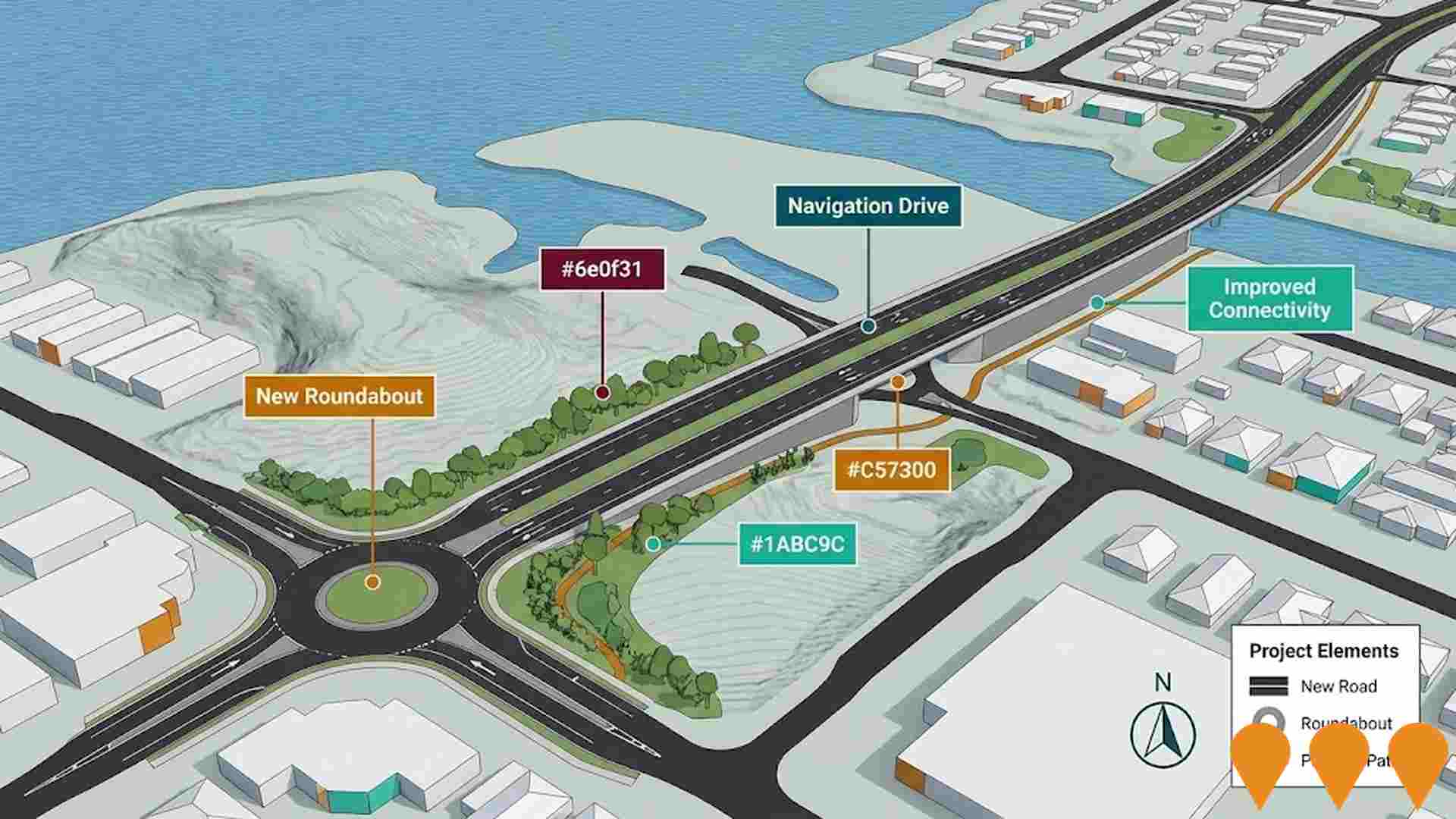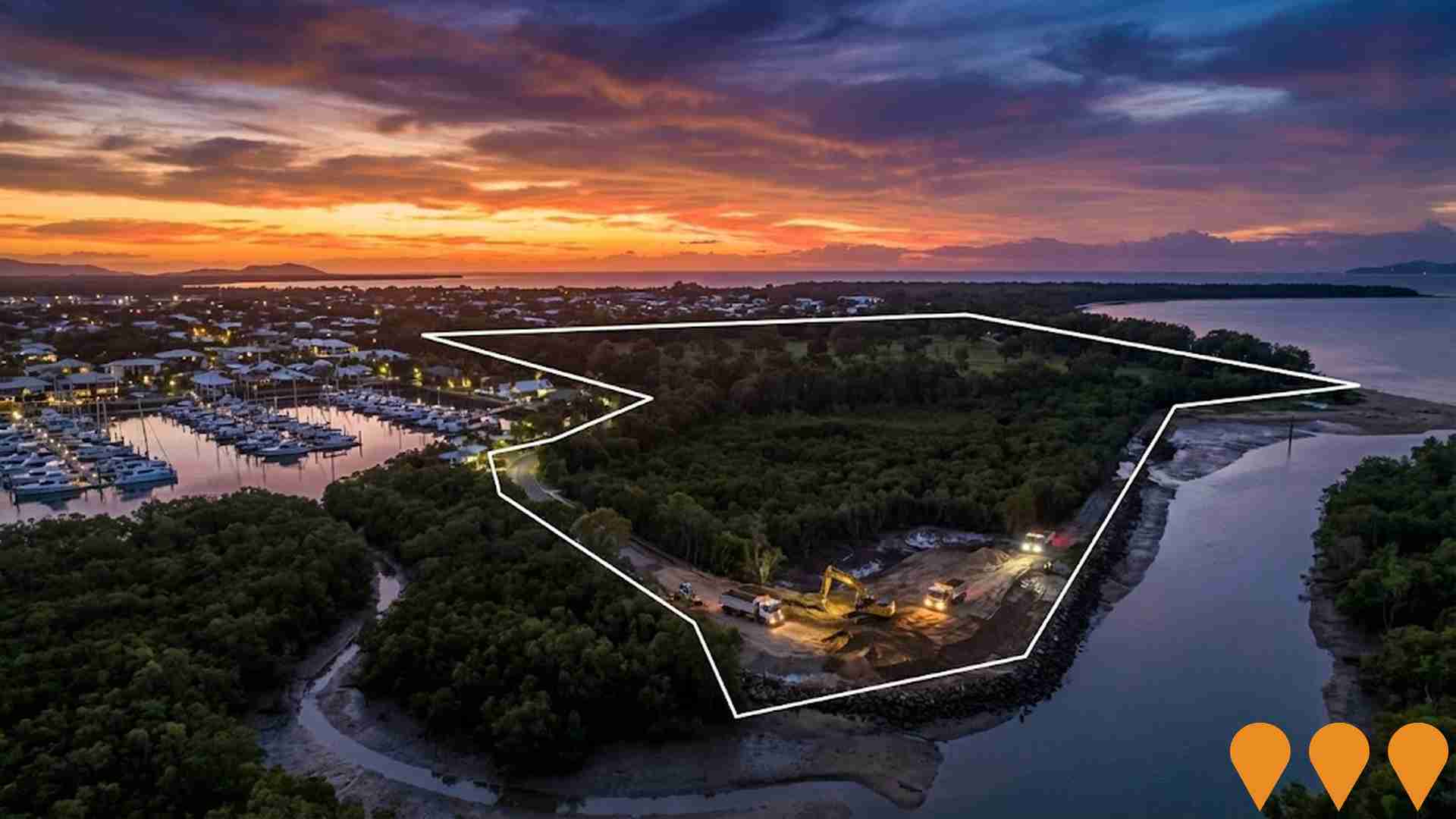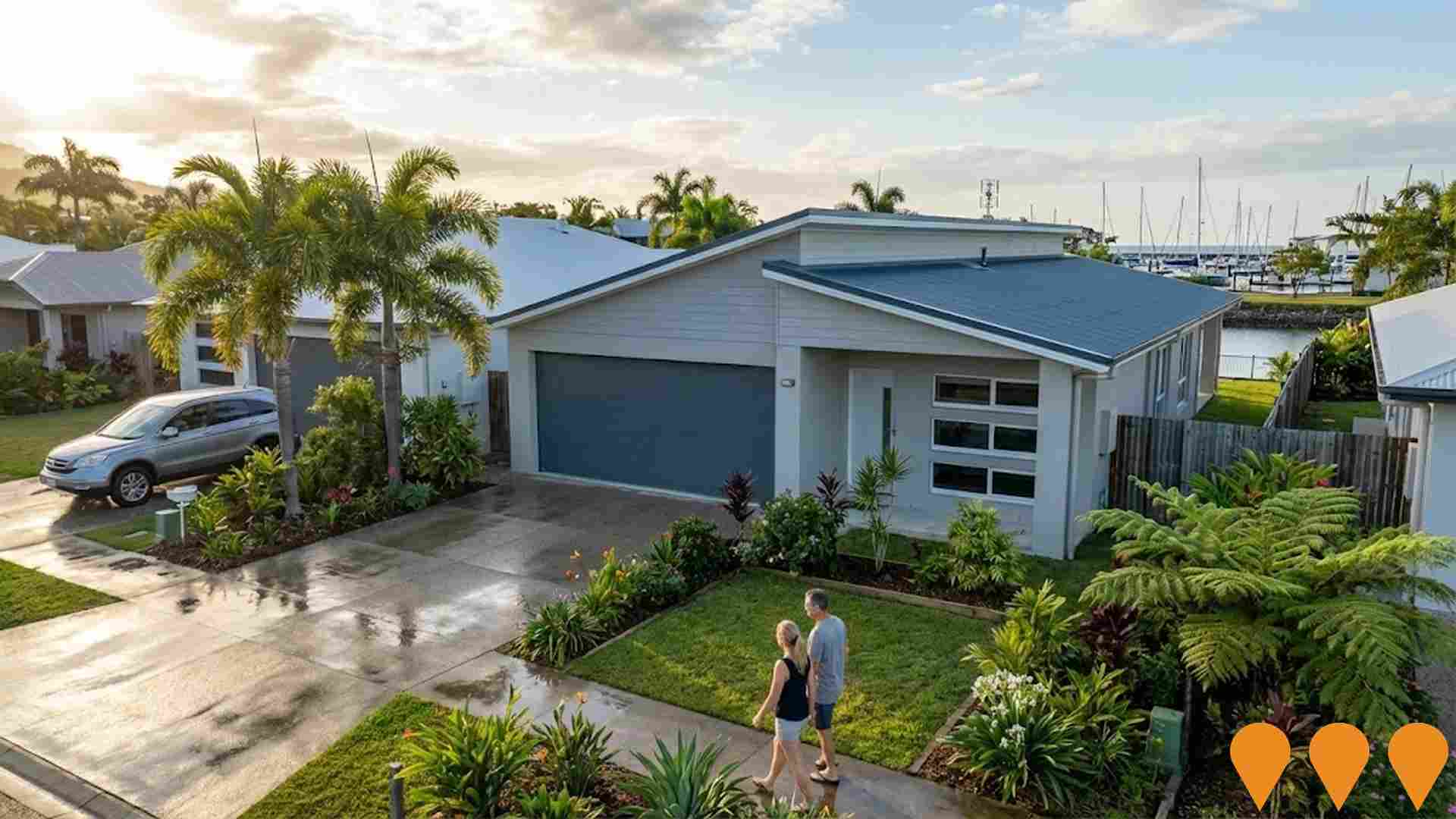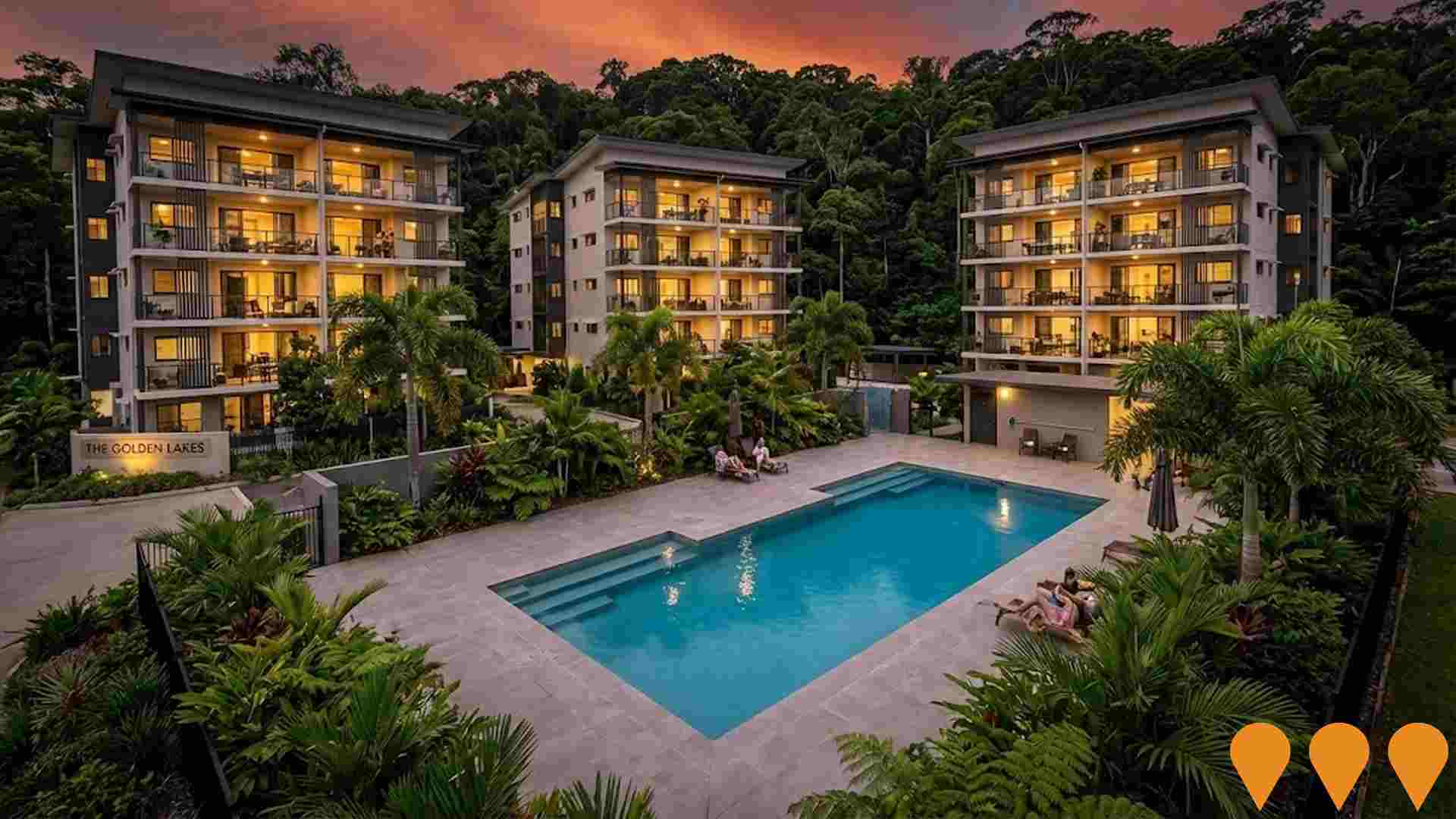Chart Color Schemes
est. as @ -- *
ABS ERP | -- people | --
2021 Census | -- people
Sales Activity
Curious about local property values? Filter the chart to assess the volume and appreciation (including resales) trends and regional comparisons, or scroll to the map below view this information at an individual property level.
Find a Recent Sale
Sales Detail
Population
Trinity Beach - Smithfield lies within the top 10% of areas nationally in terms of population growth performance according to AreaSearch analysis of short and medium-term trends
Trinity Beach - Smithfield's population was around 19,733 as of November 2025, according to AreaSearch's analysis. This figure represents an increase of 2,942 people since the 2021 Census, which reported a population of 16,791. The growth is inferred from the estimated resident population of 19,437 in June 2024 and an additional 653 validated new addresses since the Census date. This results in a population density ratio of 894 persons per square kilometer, which is relatively in line with averages across locations assessed by AreaSearch. Trinity Beach - Smithfield's growth rate of 17.5% since the 2021 census exceeded both the SA4 region (7.8%) and the non-metro area, indicating it as a growth leader in the region. Interstate migration contributed approximately 59.8% of overall population gains during recent periods, with all drivers including overseas migration and natural growth being positive factors.
AreaSearch adopts ABS/Geoscience Australia projections for each SA2 area, released in 2024 using 2022 as the base year. For areas not covered by this data and years post-2032, Queensland State Government's SA2 area projections released in 2023 based on 2021 data are used, with proportional growth weightings applied for age cohorts in line with ABS Greater Capital Region projections released in 2023 using 2022 data. Considering these projections, a significant population increase is forecast for Trinity Beach - Smithfield in the top quartile of non-metropolitan areas nationally, with an expected increase of 6,439 persons to 2041 based on the latest population numbers, representing a total increase of 31.1% over the 17-year period.
Frequently Asked Questions - Population
Development
The level of residential development activity in Trinity Beach - Smithfield was found to be higher than 90% of real estate markets across the country
Trinity Beach - Smithfield has averaged 192 new dwelling approvals each year over the past five financial years, totalling 962 homes. As of FY-26, 17 approvals have been recorded. On average, 3.5 new residents per year have moved into newly built homes between FY-21 and FY-25. This has resulted in a demand that exceeds supply, leading to price growth and increased buyer competition.
New properties are constructed at an average cost of $257,000, which is below regional norms, offering more affordable housing options for purchasers. In the current financial year, $45.3 million worth of commercial approvals have been registered, indicating high levels of local commercial activity. Compared to the rest of Queensland, Trinity Beach - Smithfield has 57.0% more development activity per person. This level is significantly above the national average, suggesting strong developer interest in the area. Recent construction consists of 97.0% standalone homes and 3.0% townhouses or apartments, maintaining the area's traditional low density character with a focus on family homes.
With around 217 people per dwelling approval, Trinity Beach - Smithfield is experiencing population growth. Future projections estimate that Trinity Beach - Smithfield will add 6,128 residents by 2041. Development activity is keeping pace with projected growth, although buyers may face increasing competition as the population expands.
Frequently Asked Questions - Development
Infrastructure
Trinity Beach - Smithfield has moderate levels of nearby infrastructure activity, ranking in the 49thth percentile nationally
Changes in local infrastructure significantly impact an area's performance. AreaSearch has identified 17 projects that could affect the area. Notable ones include James Cook University Cairns Tropical Enterprise Centre (CTEC), Woolworths Shopping Centre Trinity Beach, Half Moon Bay Estate, and Trinity Beach Shopping Centre. The following list details those most relevant.
Professional plan users can use the search below to filter and access additional projects.
INFRASTRUCTURE SEARCH
 Denotes AI-based impression for illustrative purposes only, not to be taken as definitive under any circumstances. Please follow links and conduct other investigations from the project's source for actual imagery. Developers and project owners wishing us to use original imagery please Contact Us and we will do so.
Denotes AI-based impression for illustrative purposes only, not to be taken as definitive under any circumstances. Please follow links and conduct other investigations from the project's source for actual imagery. Developers and project owners wishing us to use original imagery please Contact Us and we will do so.
Frequently Asked Questions - Infrastructure
James Cook University Cairns Tropical Enterprise Centre (CTEC)
A $180 million state-of-the-art innovation and enterprise hub at JCU's Smithfield campus in Cairns, focusing on tropical science, marine research, sustainable industries, biotechnology and advanced technology development. The centre includes research laboratories, business incubators, collaboration spaces and industry partnerships facilities.
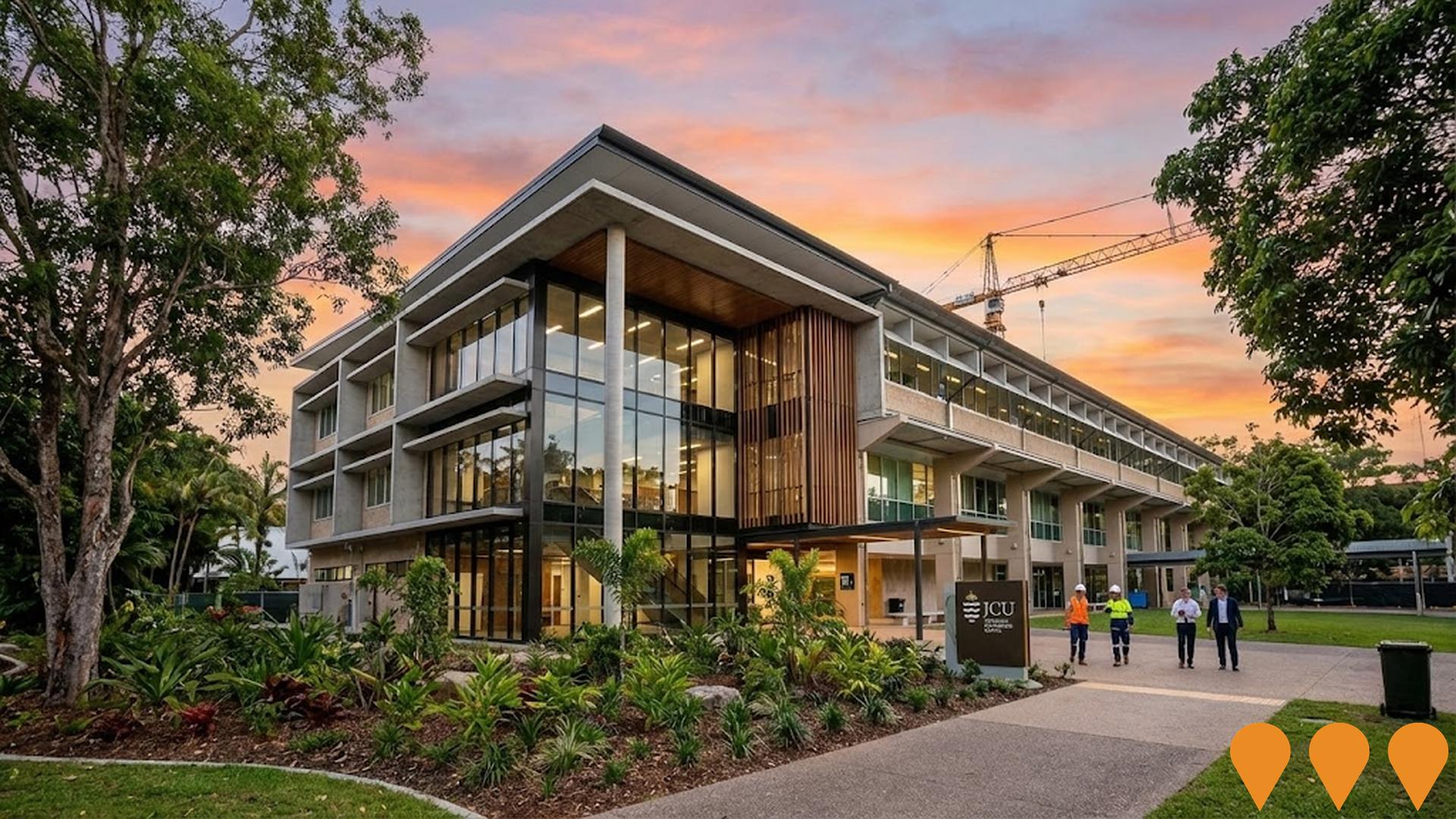
Woolworths Shopping Centre Trinity Beach
New $60 million Woolworths shopping centre development for the Cairns Northern Beaches area. The centre will include a full-line 3800sqm Woolworths supermarket, approximately fifteen speciality stores and services, and 267 car parks. Construction is aimed to start in early 2026 and is expected to take 15 months. The development is on a site at the corner of Trinity Beach Drive and Navigation Rd, adjacent to the Captain Cook Highway.
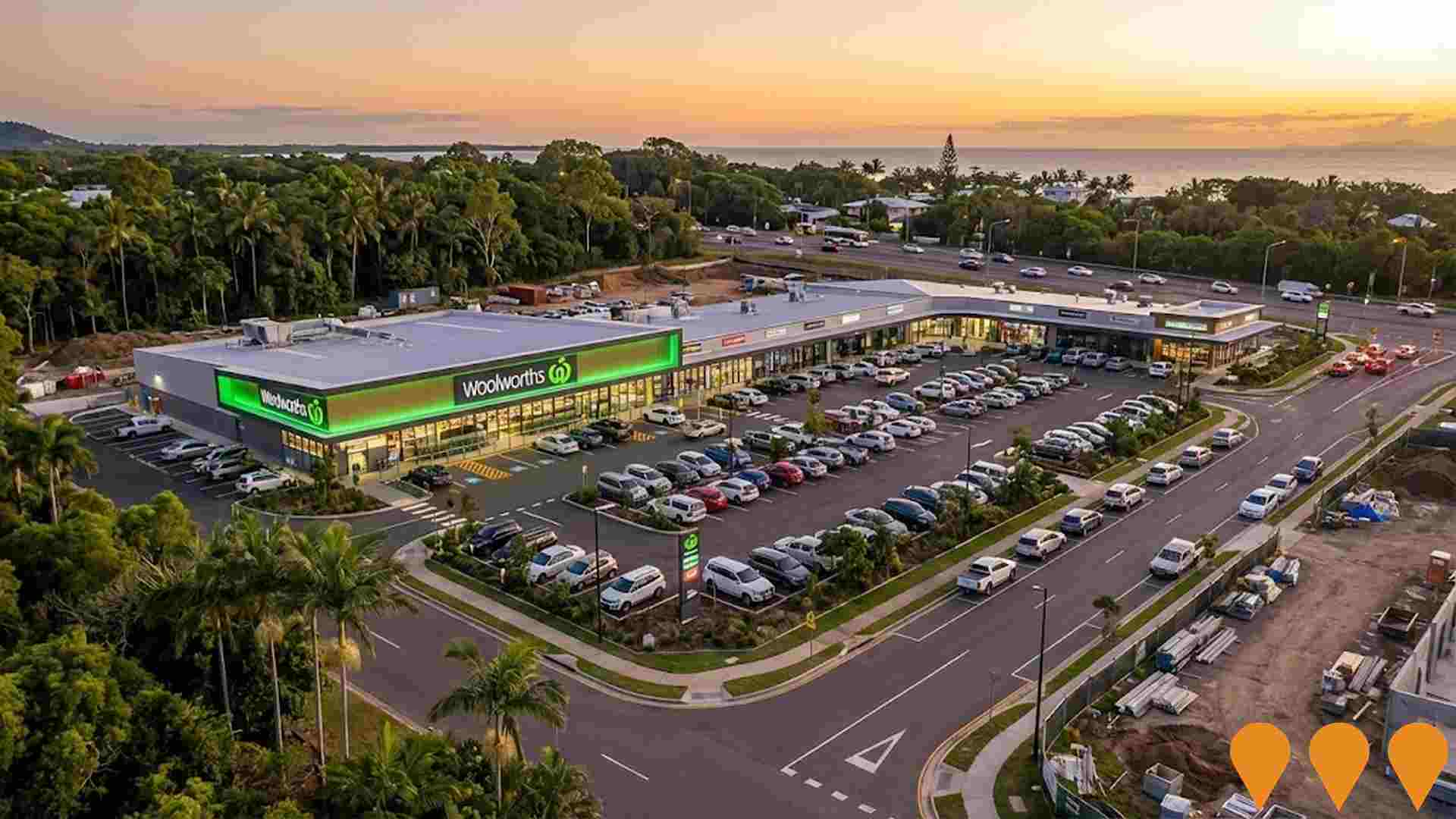
Trinity Beach Shopping Centre
A brand new shopping centre anchored by a full-line Woolworths supermarket with approximately 15 specialty retailers, including retail, service, medical, and dining options, providing essential shopping services to the northern beaches community in Cairns. The centre features abundant on-grade parking and serves an affluent trade area with strong population growth.

The Palms
The Palms is a masterplanned community redeveloping the former Paradise Palms Golf Course into a mixed-use precinct featuring premium residential lots, a retirement village, a primary school, a village hub with retail, dining, and community facilities, and the Reefsedge Waterpark & Tourist Park as a key attraction. As of 2025, construction is progressing with roadworks commencing in June and waterpark construction starting soon.
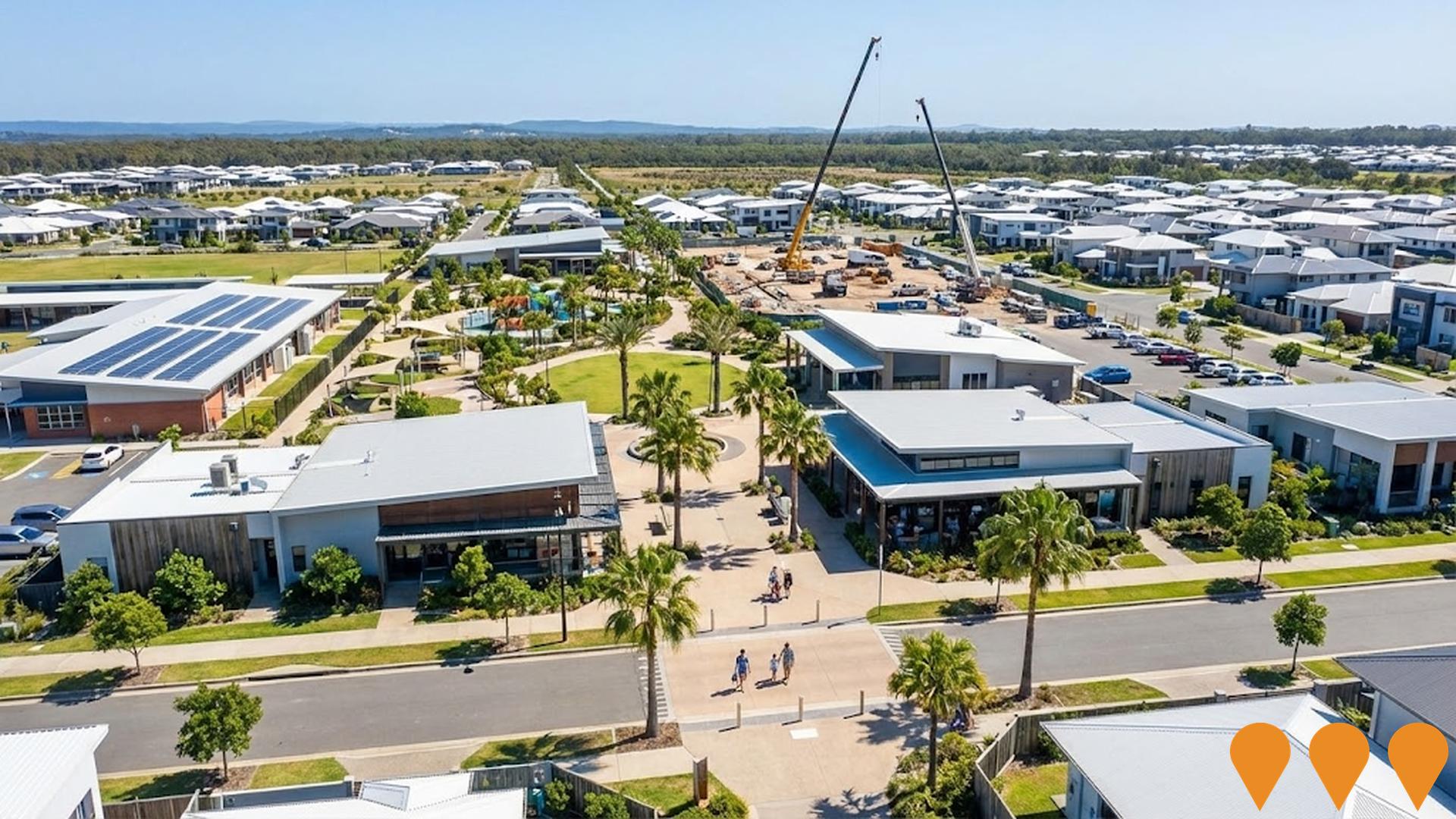
Reefsedge Resort & Waterpark
State-of-the-art waterpark and luxury resort with ensuite caravanning and camping options on the former Paradise Palms site. Council approvals granted August 2024; infrastructure charges concessions confirmed July 2025 with construction indicated to commence shortly thereafter. Features include a three-level slide tower, King Cobra slide, wave pool, lagoon pool, upgraded clubhouse, 138 villas and 127 ensuited caravan sites. Target opening Easter 2027.
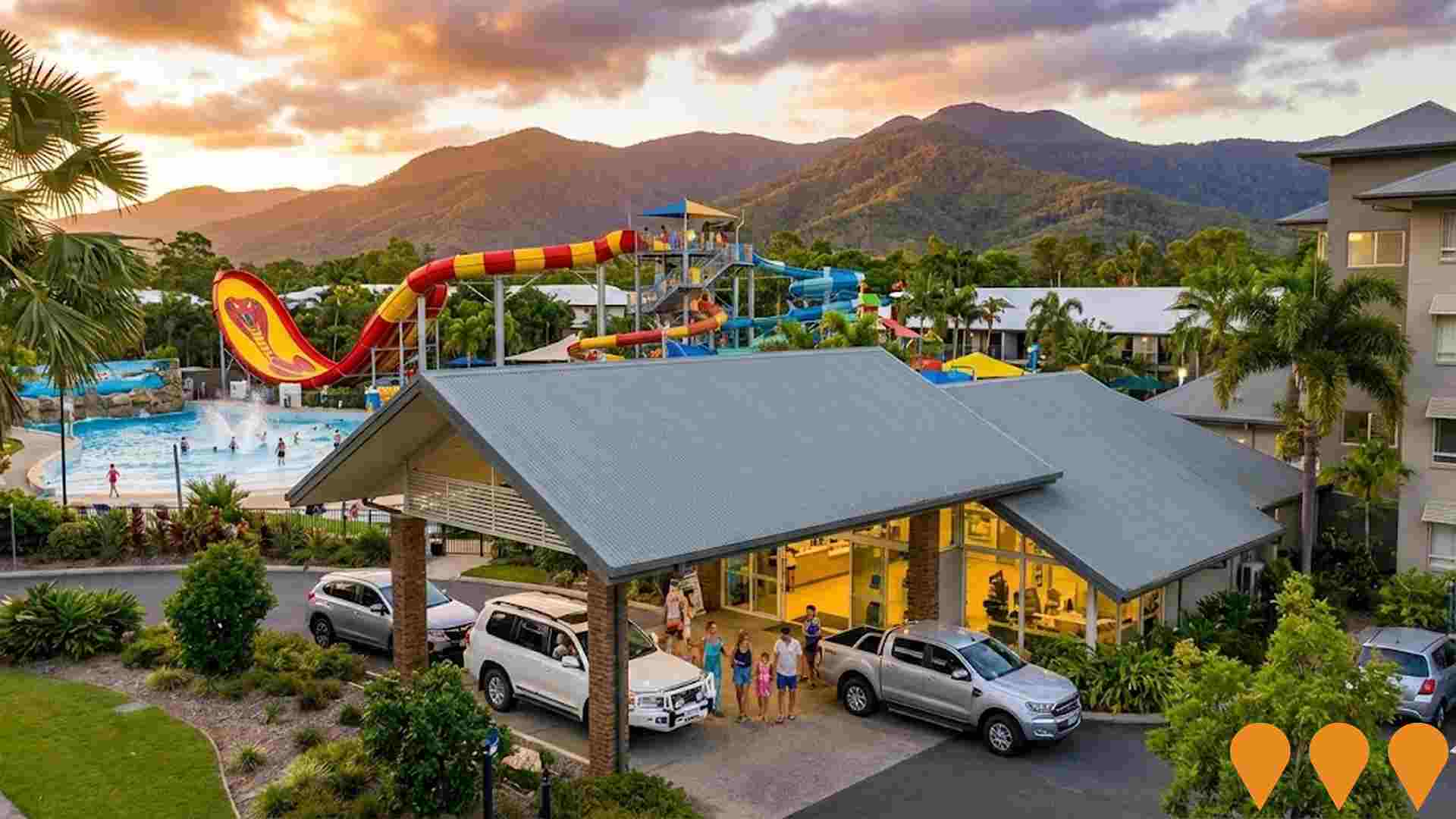
The Palms Collection Masterplan
A major $300 million mixed-use masterplan transforming the former Paradise Palms Golf Course into a sustainable community and tourist destination. The development includes a 330-lot (or 438 total lots across the masterplan) residential subdivision, a land-lease retirement village with 349 sites, a Catholic primary school, and the 'Reefsedge' tourist park featuring the approved $210 million water park, cabins, and a village hub. The project is an EnviroDevelopment certified project and is currently under construction for some stages.

Northern Beaches Water Network Upgrade
Council's 10-year program (circa $31m) to install and replace trunk and distribution water mains across Cairns' Northern Beaches to improve flow, reduce breakages, and increase reliability for about 34,000 residents. Staged delivery: Stages 1-5 completed (2015-2020), Stage 6 Kamerunga Road underway, Stage 7 Trinity Beach mains and booster station planned by Dec 2026, Stage 8 Paradise Palms to Clifton Beach trunk main planned by Jun 2032.
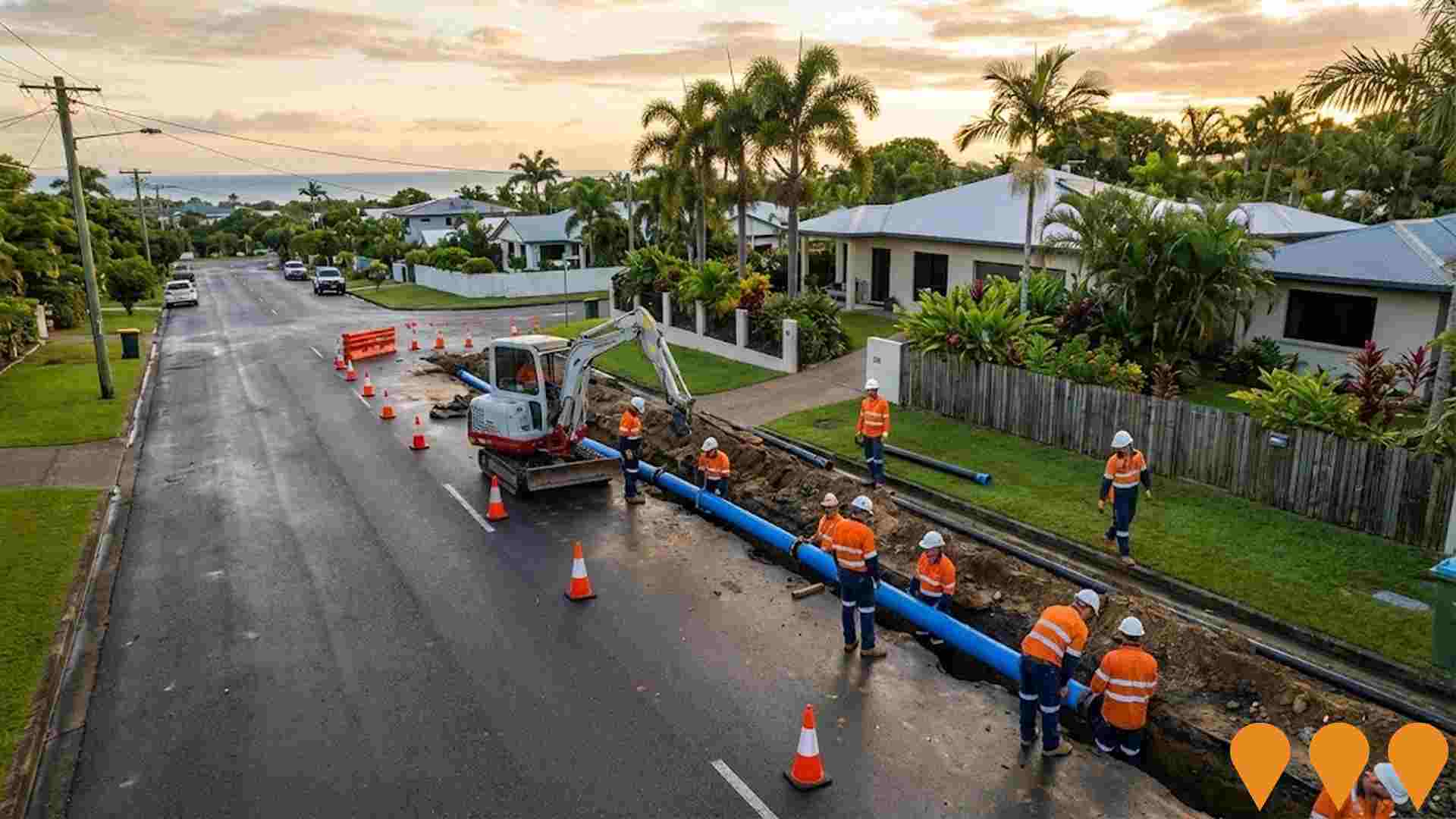
Northern Beaches Catholic Primary School
New Catholic primary school proposed within The Palms (former Paradise Palms) masterplanned precinct at Kewarra Beach to cater for growing Northern Beaches enrolments. The Diocese of Cairns has contracted land within the estate and signalled intent to open subject to funding and approvals. Timeline has shifted from an initial hope of 2025; project remains in planning pending formal approvals and delivery program.

Employment
The labour market strength in Trinity Beach - Smithfield positions it well ahead of most Australian regions
Trinity Beach - Smithfield has an unemployment rate of 1.7% as of June 2025. It has a skilled workforce with essential services sectors well represented.
There are 10,750 residents in work, which is 2.2% below the Rest of Qld's rate of 3.9%. Workforce participation is at 66.9%, compared to Rest of Qld's 59.1%. Employment among residents is concentrated in health care & social assistance (28%), accommodation & food (17%), and retail trade (14%).
Agriculture, forestry & fishing employs just 1% of local workers, below Rest of Qld's 4.5%. Between June 2024 and May 2025, the labour force decreased by 1.5%, employment declined by 1.8%, leading to a rise in unemployment rate by 0.3 percentage points. In contrast, Rest of Qld saw employment rise by 1.8% and labour force grow by 2.0%. Jobs and Skills Australia's national employment forecasts from May 2025 project a 6.6% growth over five years and 13.7% over ten years nationally. Applying these projections to Trinity Beach - Smithfield's employment mix suggests local growth of approximately 6.7% over five years and 13.9% over ten years.
Frequently Asked Questions - Employment
Income
The economic profile demonstrates above-average performance, with income metrics exceeding national benchmarks based on AreaSearch comparative assessment
According to AreaSearch's aggregation of the latest postcode level ATO data released for financial year 2022, Trinity Beach - Smithfield had a median income among taxpayers of $53,416. The average income stood at $64,789. Nationally, the median was $50,780 and the average was $64,844. Based on Wage Price Index growth of 13.99% since financial year 2022, current estimates would be approximately $60,889 (median) and $73,853 (average) as of September 2025. The 2021 Census data shows household, family and personal incomes in Trinity Beach - Smithfield cluster around the 57th percentile nationally. In this area, 36.5% of the population (7,202 individuals) fall within the $1,500 - $2,999 income range. High housing costs consume 17.0% of income. Despite this, disposable income is at the 53rd percentile nationally. The area's SEIFA income ranking places it in the 6th decile.
Frequently Asked Questions - Income
Housing
Trinity Beach - Smithfield is characterized by a predominantly suburban housing profile, with a higher proportion of rental properties than the broader region
Trinity Beach - Smithfield's dwelling structures, as per the latest Census, consisted of 82.7% houses and 17.3% other dwellings (semi-detached, apartments, 'other' dwellings). This compares to Non-Metro Qld's 80.8% houses and 19.2% other dwellings. Home ownership in Trinity Beach - Smithfield was at 25.4%, with mortgaged dwellings at 42.0% and rented ones at 32.7%. The median monthly mortgage repayment was $1,733, aligning with Non-Metro Qld's average. The median weekly rent figure was $420, compared to Non-Metro Qld's $390. Nationally, Trinity Beach - Smithfield's mortgage repayments were lower than the Australian average of $1,863, while rents were substantially higher at $420 versus the national figure of $375.
Frequently Asked Questions - Housing
Household Composition
Trinity Beach - Smithfield features high concentrations of group households, with a higher-than-average median household size
Family households account for 74.4% of all households, including 30.7% couples with children, 30.4% couples without children, and 12.2% single parent families. Non-family households constitute the remaining 25.6%, with lone person households at 20.9% and group households comprising 4.7%. The median household size is 2.6 people, larger than the Rest of Qld average of 2.5.
Frequently Asked Questions - Households
Local Schools & Education
The educational profile of Trinity Beach - Smithfield exceeds national averages, with above-average qualification levels and academic performance metrics
The area's educational profile is notable regionally, with university qualification rates at 25.7% among residents aged 15+, exceeding the Rest of Qld average of 20.6%. Bachelor degrees are most common at 17.7%, followed by postgraduate qualifications (5.3%) and graduate diplomas (2.7%). Vocational credentials are also prevalent, with 40.9% of residents aged 15+ holding such qualifications – advanced diplomas account for 12.9% and certificates for 28.0%.
Educational participation is high at 32.7%, including 10.8% in primary education, 8.4% in secondary education, and 7.2% pursuing tertiary education. The area's four schools have a combined enrollment of 3,110 students, operating under typical Australian school conditions (ICSEA: 1018) with balanced educational opportunities. Educational provision is conventional, split between two primary and two secondary institutions.
Frequently Asked Questions - Education
Schools Detail
Nearby Services & Amenities
Transport
Transport servicing is low compared to other areas nationally based on assessment of service frequency, route connectivity and accessibility
Trinity Beach - Smithfield has 52 active public transport stops. These are served by a mix of buses along nine different routes, offering a total of 1,564 weekly passenger trips. The area's transport accessibility is rated as good, with residents located an average of 329 meters from the nearest stop.
Services run frequently, with an average of 223 trips per day across all routes, equating to approximately 30 weekly trips per individual stop.
Frequently Asked Questions - Transport
Transport Stops Detail
Health
Trinity Beach - Smithfield's residents are extremely healthy with very low prevalence of common health conditions across all age groups
Analysis of health metrics shows strong performance throughout Trinity Beach-Smithfield, with very low prevalence of common health conditions across all age groups.
The rate of private health cover is approximately 52%, leading that of the average SA2 area (~10,241 people). Mental health issues and arthritis are the most common medical conditions in the area, impacting 7.6% and 6.8% of residents respectively. A total of 74.5% of residents declare themselves completely clear of medical ailments, compared to 73.1% across Rest of Qld. The area has 14.8% of residents aged 65 and over (2,918 people), which is lower than the 16.7% in Rest of Qld. Health outcomes among seniors are particularly strong, broadly in line with the general population's health profile.
Frequently Asked Questions - Health
Cultural Diversity
Trinity Beach - Smithfield was found to be more culturally diverse than the vast majority of local markets in Australia, upon assessment of a range of language and cultural background related metrics
Trinity Beach-Smithfield has a higher cultural diversity than most local areas, with 14.2% of its residents speaking a language other than English at home and 28.0% born overseas. Christianity is the predominant religion in Trinity Beach-Smithfield, comprising 42.7% of its population. Judaism, while still a minority, is more prevalent in Trinity Beach-Smithfield at 0.2%, compared to the regional average of 0.2%.
The top three ancestry groups are English (28.1%), Australian (23.1%), and Other (10.8%). Notably, New Zealand (1.0% vs 0.9%), French (0.7% vs 0.7%), and Welsh (0.7% vs 0.6%) ethnic groups are equally or more represented in Trinity Beach-Smithfield compared to the regional averages.
Frequently Asked Questions - Diversity
Age
Trinity Beach - Smithfield's population is slightly younger than the national pattern
The median age in Trinity Beach - Smithfield is 38 years, which is slightly below Rest of Qld's average of 41 but aligns with Australia's median age of 38. The age group of 35-44 has a strong representation at 15.2%, compared to Rest of Qld's figure. Conversely, the 75-84 cohort is less prevalent at 4.3%. According to post-2021 Census data, the 35 to 44 age group has increased from 14.4% to 15.2%, while the 45 to 54 group has declined from 14.1% to 12.6% and the 5 to 14 group has dropped from 13.8% to 12.8%. Population forecasts for 2041 suggest significant demographic changes in Trinity Beach - Smithfield. Notably, the 25 to 34 age group is projected to grow by 49%, adding 1,361 people and reaching a total of 4,158 from the current figure of 2,796. In contrast, the 15 to 24 cohort shows minimal growth of just 7%, with an increase of 169 people.
